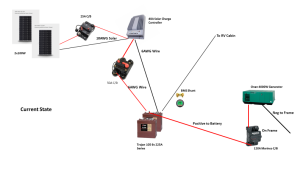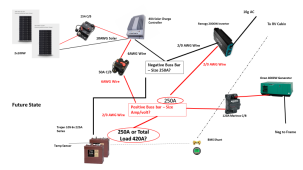mmlco
New Member
- Joined
- Mar 15, 2022
- Messages
- 6
Following Will's 400W DIY Solar using only 200W solar for now.
RV Current Setup: 2x100W Renogy Solar panels, 10AWG Solar wire, 25A C/B (+), 10AWG Solar wire, 40A MPPT SCC, 6AWG Wire, 50A C/B (+), 6AWG Wire to Trojan 105 6v 225A wired in series. BMS Shunt. Onan 4000W Generator also connected to batteries via 120A C/B (+) on RV frame; negative grounded on RV frame.
RV Future State: Add a 2000W Renogy Inverter with 2/0 inverter cables and 250A fuse. I would prefer to use both positive and negative buss bars (4 post each) to cleanup wire routing and wires on the battery post. So 3 items Solar Charge Controller - Inverter - Generator onto a positive buss bar. I saw the recommendation is 250A for the negative buss bar in an updated Will's alternator version of this 400W setup. Feedback appreciated.
Question 1: Do I use 250A positive buss barr?
Question 2: Is the Protection Device between positive buss bar and batteries SSC 40A + Generator 120A + Inverter 250A = 410A OR SSC C/B 50A + Generator 120A + Inverter 250A = 420A?
Question 3: Do I need to increase from the 2/0 wire from the positive buss barr to battery?


RV Current Setup: 2x100W Renogy Solar panels, 10AWG Solar wire, 25A C/B (+), 10AWG Solar wire, 40A MPPT SCC, 6AWG Wire, 50A C/B (+), 6AWG Wire to Trojan 105 6v 225A wired in series. BMS Shunt. Onan 4000W Generator also connected to batteries via 120A C/B (+) on RV frame; negative grounded on RV frame.
RV Future State: Add a 2000W Renogy Inverter with 2/0 inverter cables and 250A fuse. I would prefer to use both positive and negative buss bars (4 post each) to cleanup wire routing and wires on the battery post. So 3 items Solar Charge Controller - Inverter - Generator onto a positive buss bar. I saw the recommendation is 250A for the negative buss bar in an updated Will's alternator version of this 400W setup. Feedback appreciated.
Question 1: Do I use 250A positive buss barr?
Question 2: Is the Protection Device between positive buss bar and batteries SSC 40A + Generator 120A + Inverter 250A = 410A OR SSC C/B 50A + Generator 120A + Inverter 250A = 420A?
Question 3: Do I need to increase from the 2/0 wire from the positive buss barr to battery?




